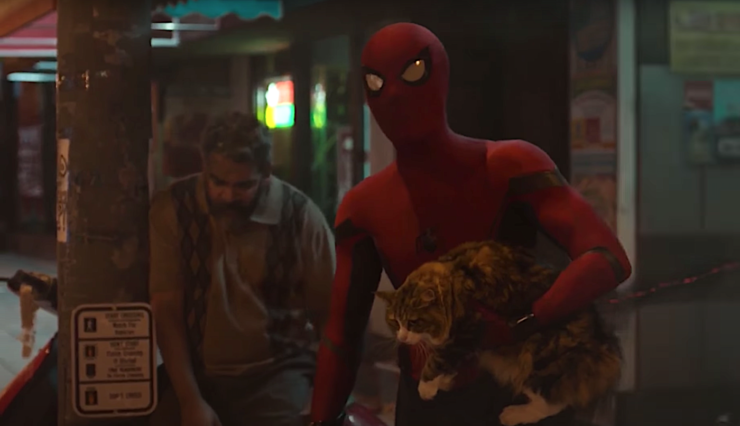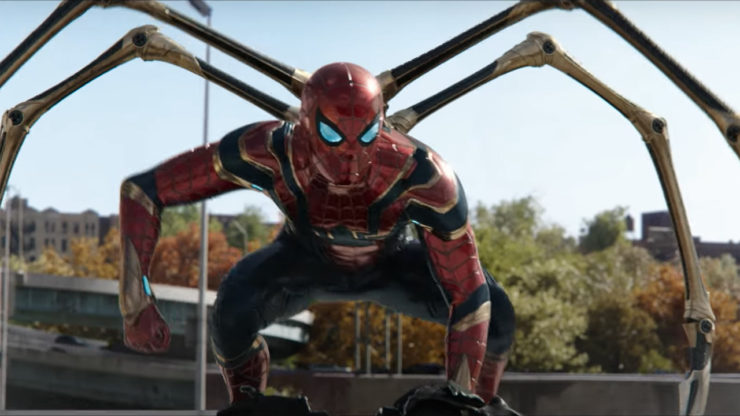…OK there are a few Most Important Scenes, I’ll admit that.
I might have uhhh screamed, real loud, at least five times during this film. I really loved it, I thought it finally gave the MCU’s Peter Parker a great story of his own, free of Tony Stark and his complications, while also balancing a wide cast of characters and a ton of expectations.
And from here I’ll have to get into spoiler territory, so only come with me if you’ve seen the film, or don’t care about knowing some STUFF.
When Tom Holland’s Spider-Man made his debut in Captain America: Civil War in 2016, I was ALL IN. I loved how we were finally getting a genuine teenage Peter Parker, played by an actor who was only a little older than his character. I loved Holland’s take on the role—he was believably naive and well-meaning, would refer to Empire Strikes Back and Alien as “old movies” without noticing the wincing of his elder teammates, and his desperation to hurry up and be an Avenger was both sweet and realistically grating. I enjoyed Homecoming and Far From Home, as well as his roles in Infinity War and Endgame.
At the same time, I understood why some people were frustrated by this take on the character. As I’ve written before, Marvel stories are very much New York stories. They are grounded in this city, dedicated to a sense of PLACE, sometimes to a comical degree. (I’m looking straight into your eyes, Netflix/Marvel shows, acting like Harlem and Hell’s Kitchen are neighboring fiefdoms separated by miles of barren, bodega-less tundra rather than a 20-minute ride on the 1 train) And while the MCU’s take on Peter Parker started out strong—Peter and his Aunt May live in a small apartment in Queens, she’s a community organizer, he goes to a public school in Midtown that he tested into, he rescues a bodega cat during his first solo film. Good stuff!—but he also simply wasn’t local enough. Even apart from the plot where he fights an alien in space, one of his own movies takes place on a field trip all over Europe. As fun as it is, he’s a long way from Forest Hills.

The other issue of course is that he became more and more Tony Stark, Jr. The fact that you’re a working-class orphan from Queens doesn’t mean much when you can text the Earth’s Mightiest Heroes. The struggles of high school pale when you can basically go be an intern for the most famous man in the world any time you want. And even after Tony’s gone, Peter has the EDITH glasses and an aunt who absolutely supports his heroic activities, and Tony’s bff Happy Hogan to be an uncle figure-turned-maybe-actual-step-uncle. And yes, part of the awesomeness is that Peter remains grounded and sweet despite all the giant MCU shenanigans (“Oh! We’re using our made up names! Then, I am Spider-Man.”) but this version of Spider-Man has always felt worlds apart from Toby Maguire’s or Andrew Garfield’s.
But No Way Home fixes that. Hell, it fixes everything.
As my beloved colleague Emmet said in their review, “How could any one movie hope to pack so much Spider-Man into its tiny frame? The answer turns out to be relatively simple, in fact—it had to focus on what makes Spider-Man special, which has always been his need to help others.” Because the MCU Spider-Man has been dealing with giant macro issues in his own movies and in his adventures with the Avengers, we don’t often get to see him just be a caring, empathetic nerd. No Way Home remembers that this is the core of the character, and fixes its own tangled arc by making that the center of the story. Peter cares about these supervillains. He risks his own life, repeatedly, to try to heal them and send them back home whole. He uses his giant brain to come up with cures for them. He battles a wizard for them. He keeps risking his life to help them even after they’ve all tried to kill him, and even after one of them kills Aunt May. And it only works because he has the other two Spider-Men working beside him—the only superheroes in all the Multiverse who would be willing to do something this crazy just because it’s the right thing to do. (OK, maybe Nightcrawler would help, but he might not exist in this multiverse, and he’d be useless in a lab anyway.) This doesn’t just finally give the MCU’s Spider-Man a perfectly Peter Parker-y plot, it also retroactively gives Raimi and Webb’s films more satisfying conclusions, where their villains are reformed rather than killed. The whole movie revels in the specific moral universe that Spider-Man allows, where the point of being a hero is not fighting bad guys but working toward justice, and each moment in the film is carefully built to steer us away from violence and into forgiveness, redemption, and healing. (You know, something something cool youth pastor.)
No Way Home is about different types of second chances. Peter Parker wants a second chance for his friends to live normally, to go to MIT, to not have his actions as Spider-Man held against them. Obviously, the Rogue’s Gallery all get their own redemption arcs. And Peter’s fellow Spider-Men also get their second chances. Where the Raimiverse Peter Parker couldn’t save his best friend Harry from turning to the dark side and ruining his life on a quest for revenge, here he puts his own body between MCU Peter Parker and Norman Osborne, stopping the youngest Spidey from putting vengeance ahead of justice. Where the Webbverse Peter Parker failed to save Gwen Stacey, here he’s able to save the MCU’s MJ. (On top of that, the actor who had some really public issues with how he was treated by the superhero industrial complex also gets to receive love and admiration from the other two Spideys—the only people who understand how tough this job is, both in-universe and in the more meta way.)
But the MCU Peter’s second chance takes a very different form. Peter is stripped of everything. Every connection to Stark Industries—even Happy. His ties to the Avengers. His best friend and girlfriend. Where the others get to go home healed, Peter has to do it wounded, grieving, and naked. The movie is reminding us that sometimes going after a second chance hurts way more than just keeping your head down and maintaining the status quo. If you don’t mind a slight stretch, it’s showing us what happens to people who try to tell a different kind of story. After all, the version of this movie where Peter sent the villain homes to their deaths ends with Peter going home to an alive Aunt May, with an MIT Dean pleading his case up in Boston. Even the version that ended in the usual MCU CGI-slugfest ends with Peter going off to MIT, starting a new life sharing a dorm with Ned, MJ a few doors away, older and wiser from having yet again thwarted an evil and saved New York. But in this version of the story, Peter chooses the thing that Spider-Man always has to choose: he fights with his brain, to use his nerdiness as a vehicle for his empathy. And in the one moment when he slipped up and couldn’t forgive Norman? A different version of himself was there to save him from his own anger, while a second version was there to pass the cure over.
What’s the true story of Peter Parker? He always does the right thing, no matter how much it destroys him. He does the right thing in healing his Rogue’s Gallery. But the multiverse doesn’t care that a teenager was trying to work out a couple of redemption arcs—it’s still going to fracture because of the tainted spell. So Peter does the right thing, and asks Stephen Strange to work the original spell, and it destroys him.
His destruction is his second chance.
Not the uplift of Doc Ock using his tentacles for good, or Electro and Webbverse Spidey sharing a heartfelt moment together, but the stark reality of starting over from nothing. This isn’t even going back to the beginning—this is New York’s best hero thrown fully on his own wits. Peter, an orphan twice over now, has to move into a single bare room and reboot his hero career from scratch. All of his friendships, his connections to Stark Industries, his ties to the Avengers—they’re all gone. But this is where the film shows us why Spider-Man has been such an enduring hero: starting over from less than nothing sucks, sure, but Peter’s not going to give up or give in or back down. This is where he becomes most himself. (And yes, we’re coming to that important scene, now.)
Peter looks at this tiny, dingy room, and smiles. He brings a couple of cardboard boxes in, alone. He opens his phone to track emergency calls—presumably the same way he used to find people in need, way back before Tony found him. And then the camera turns and holds: a sewing machine with a half-finished, red-and-blue suit spilling across the table next to Ned’s old Emperor Palpatine LEGO, and the blue-and-white “We Are Happy To Serve You” paper cup. The incongruous sewing skills that imply either a history of crafting (with Aunt May, maybe, or Uncle Ben? Or long ago, with his mom?) or, my personal read, he was poor enough that he learned how to patch his clothes. A toy that stands as a tie to his childhood, his lost best friend, and his lifelong nerd-dom. And that fucking coffee cup. That last, disposable, inadequate tie to MJ. That innocuous paper icon of life in New York, the great equalizer, the cup that is carried by Wall Street bros and MTA workers alike. That underlines the point of Spider-Man: he isn’t flying around the world living playboy fantasies like Tony, or studying arcane arts like Strange, or searching for a found family like Star-Lord—when he was given great power he took on the responsibility for his city. He’s never going to plaster his name on a tower to look down on Manhattan, or stalk dramatically through a West Village mansion. He is that cup: sturdy and unassuming, and he’ll be there for any New Yorker who needs him.
And that’s why Spider-Man is the fucking BEST.
Leah Schnelbach may have said “This movie is my Citizen Kane” at one point, out loud, in the theater. THEY REGRET NOTHING. Come talk to them about all those surprise appearances on Twitter!










